May Caesar bless you! Looking forward to it.
Ancient letter written by Roman emperor leads archaeologists to "monumental" discovery in Italy
The expedition's lead archaeologist announced the find at the Archaeological Institute of America's annual meeting.www.cbsnews.com
Mind blowing article of fresh new Discovery in Italy that to me is the final proof. About Caesar being venerated in the eastern provinces there is the famous Greek inscription from the Corpus Inscriptionum Graecarum (number 2957) :
“Gaius Julius Caesar…Chief Priest…God made manifest and common Saviour of Mankind.”
Lastly About the images of Jesus and the coins tomorrow I will post some Academic sources and places where they were found so I don’t leave you with the youtube video only
You are using an out of date browser. It may not display this or other websites correctly.
You should upgrade or use an alternative browser.
You should upgrade or use an alternative browser.
Was Julius Caesar the real Jesus Christ?
- Thread starter Laura
- Start date

Ancient letter written by Roman emperor leads archaeologists to "monumental" discovery in Italy
The expedition's lead archaeologist announced the find at the Archaeological Institute of America's annual meeting.www.cbsnews.com
Mind blowing article of fresh new Discovery in Italy that to me is the final proof. About Caesar being venerated in the eastern provinces there is the famous Greek inscription from the Corpus Inscriptionum Graecarum (number 2957) :
“Gaius Julius Caesar…Chief Priest…God made manifest and common Saviour of Mankind.”
Lastly About the images of Jesus and the coins tomorrow I will post some Academic sources and places where they were found so I don’t leave you with the youtube video only
Fascinating! I noticed that the article claims that the Imperial Cult started after the death of Cesar as a form of ancestor worship, but as we've seen, this isn't exactly correct: Cesar was worshipped as a living god, and indeed this continued with Augustus and the later emperors - but with them, arguably in large parts because of their descendence from Cesar.
divusiulius
The Force is Strong With This One
Yes of course you are right! It’s important to point out. Have you ever heard of this book?Fascinating! I noticed that the article claims that the Imperial Cult started after the death of Cesar as a form of ancestor worship, but as we've seen, this isn't exactly correct: Cesar was worshipped as a living god, and indeed this continued with Augustus and the later emperors - but with them, arguably in large parts because of their descendence from Cesar.
I tried to find an english version since I can’t read german but I think there isn’t one.
If I remember correctly, there are some conflicting scholarly opinions on this, but I think the best evidence is that while Caesar may have been worshiped in the provinces, it wasn't until after his death that the imperial cult actually started up in Rome.Fascinating! I noticed that the article claims that the Imperial Cult started after the death of Cesar as a form of ancestor worship, but as we've seen, this isn't exactly correct: Cesar was worshipped as a living god, and indeed this continued with Augustus and the later emperors - but with them, arguably in large parts because of their descendence from Cesar.
I thought Egypt was completely under the dominion of Rome by that time.Roman provinces on the eve of the Assassination of Julius Caesar (Wikipedia):
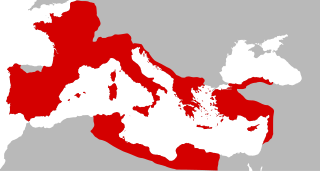
If I remember correctly, there are some conflicting scholarly opinions on this, but I think the best evidence is that while Caesar may have been worshiped in the provinces, it wasn't until after his death that the imperial cult actually started up in Rome.
It seems to me that what happened is that Cesar was worshiped as a living God, and even elevated among the official "State gods", i.e. part of the mainstream religion if you will. He obviously was hugely popular. But since he was a humble guy, he resisted it to an extent, although he also didn't stop it. But he didn't foster it either or pushed it into a sophisticated cult. But that didn't stop people in the provinces, especially veterans, from forming a cult.
Now with Augustus and the later emperors, they were less humble, and pushed the cult thing to strengthen the connection with Cesar and their power. Hence the full-blown cult in Rome eventually.
It seems modern scholars often can't wrap their heads around the idea of worshiping a living god, and so emphasize the ancestor worship thing. But for the Romans and the ancients in general, the boundary between the realm of gods and the realm of men was much softer than what we are used to thinking these days.
Yes of course you are right! It’s important to point out. Have you ever heard of this book?
I tried to find an english version since I can’t read german but I think there isn’t one.
That sounds fascinating, I'll order it today!
Yeah, it does. Here's the deepl translation of the blurb:
"An hour-long darkening of the sun, a massive earthquake, shattered stones, destruction in the temple, a blood-red moon and the resurrection of the dead... according to the Gospels and other Christian sources, this massive natural disaster with supernatural features occurred during the crucifixion of Christ. But no ancient historian ever said a word about it. Is it all just fiction? However, the same phenomena occurred a few decades earlier when Julius Caesar was murdered in Rome. Was it all fiction? Using a new theory on the origin of the Gospels, this historical investigation provides evidence that the Christian stories are in fact true history that has merely been rewritten: from Rome to Jerusalem... from Caesar to Christ."
"An hour-long darkening of the sun, a massive earthquake, shattered stones, destruction in the temple, a blood-red moon and the resurrection of the dead... according to the Gospels and other Christian sources, this massive natural disaster with supernatural features occurred during the crucifixion of Christ. But no ancient historian ever said a word about it. Is it all just fiction? However, the same phenomena occurred a few decades earlier when Julius Caesar was murdered in Rome. Was it all fiction? Using a new theory on the origin of the Gospels, this historical investigation provides evidence that the Christian stories are in fact true history that has merely been rewritten: from Rome to Jerusalem... from Caesar to Christ."
Still going off my not-so-perfect memory here, but I think some distinctions still need to be made here. The boundary between gods and men for the Romans (at least, the Roman elite, not necessarily the plebs, about whom we probably don't know as much) of Caesar's time arguably wasn't as soft as it was in the provinces. In the book Cicero and the Rise of Deification in Rome, Spencer Cole basically argues that Cicero slowly, and over time, introduced this possibility into Roman official culture - primarily with the purpose of deifying himself. In a sense, he loosened up the Roman mentality that allowed for the deification of Caesar. But the Romans in general were much less open to the idea of a living god than the "Greeks" - Cicero wouldn't have had to try so hard if it was already a live option, I think. Again, maybe that didn't apply so much to the lower classes, who may have been more open to seeing things in those terms.It seems modern scholars often can't wrap their heads around the idea of worshiping a living god, and so emphasize the ancestor worship thing. But for the Romans and the ancients in general, the boundary between the realm of gods and the realm of men was much softer than what we are used to thinking these days.
Still going off my not-so-perfect memory here, but I think some distinctions still need to be made here. The boundary between gods and men for the Romans (at least, the Roman elite, not necessarily the plebs, about whom we probably don't know as much) of Caesar's time arguably wasn't as soft as it was in the provinces. In the book Cicero and the Rise of Deification in Rome, Spencer Cole basically argues that Cicero slowly, and over time, introduced this possibility into Roman official culture - primarily with the purpose of deifying himself. In a sense, he loosened up the Roman mentality that allowed for the deification of Caesar. But the Romans in general were much less open to the idea of a living god than the "Greeks" - Cicero wouldn't have had to try so hard if it was already a live option, I think. Again, maybe that didn't apply so much to the lower classes, who may have been more open to seeing things in those terms.
Yeah. I think the Romans thought of themselves as too rational and realistic and held the Eastern customs in some contempt, thus Cicero, pushing Greek culture.
If anybody reads this other book, perhaps they will write a review and refer the author to FPTM for additional support of the thesis.
Or maybe he needed to try so hard because... he was CiceroCicero wouldn't have had to try so hard if it was already a live option, I think.

Interesting angle anyway about the Roman "rationalism" and Cicero's role. It seems Clauss (author of the paper above) sought to "relativize" all this a bit, by showing Cesar's State God status and citing a few scholars who seemed to use language that downplayed this whole aspect, even mistranslating certain inscriptions that in a different context would have been clearly interpreted as ascribing god-status to a living human. But both angles don't seem mutually exclusive. Like, Cesar played a big role, as did Cicero and the "Greekization", while there had been precedents of "living gods" that could be built upon. And I found Clauss' angle that Cesar resisted this trend somewhat, but Augustus and the others sought to strengthen their connection to Cesar ("son of a god"), interesting too.
How significant is this discovery? Or rather, what is its significance?
Ancient letter written by Roman emperor leads archaeologists to "monumental" discovery in Italy
The expedition's lead archaeologist announced the find at the Archaeological Institute of America's annual meeting.www.cbsnews.com
Mind blowing article of fresh new Discovery in Italy that to me is the final proof. About Caesar being venerated in the eastern provinces there is the famous Greek inscription from the Corpus Inscriptionum Graecarum (number 2957) :
“Gaius Julius Caesar…Chief Priest…God made manifest and common Saviour of Mankind.”
Another report on it:
Roman Imperial Cult Temple Unearthed Beneath a Parking Lot in Italy
The pagan temple sheds new light on the empire’s gradual embrace of Christianity
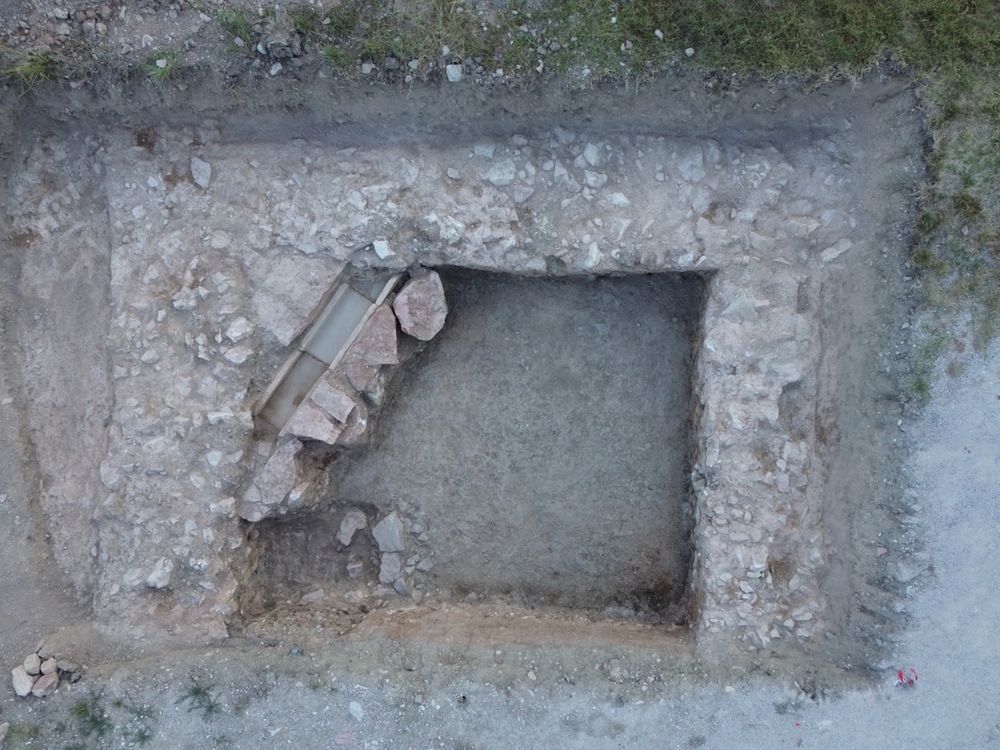
In a small town north of Rome, researchers have unearthed a 1,600-year-old temple dedicated to a Roman emperor’s ancestors. Built during the reign of Constantine in the fourth century C.E., the structure sheds light on the empire’s transition from pagan worship to Christianity.
As Saint Louis University historian Douglas Boin recently announced at the Archaeological Institute of America’s annual meeting, he and his team discovered three walls of the “monumental structure” in Spello, Italy, during excavations last summer.
“It will significantly aid in the understanding of the ancient town, the ancient townscape and city society in the later Roman Empire,” says Boin in a statement. “It shows the continuities between the classical pagan world and early Christian Roman world that often get blurred out or written out of the sweeping historical narratives.”
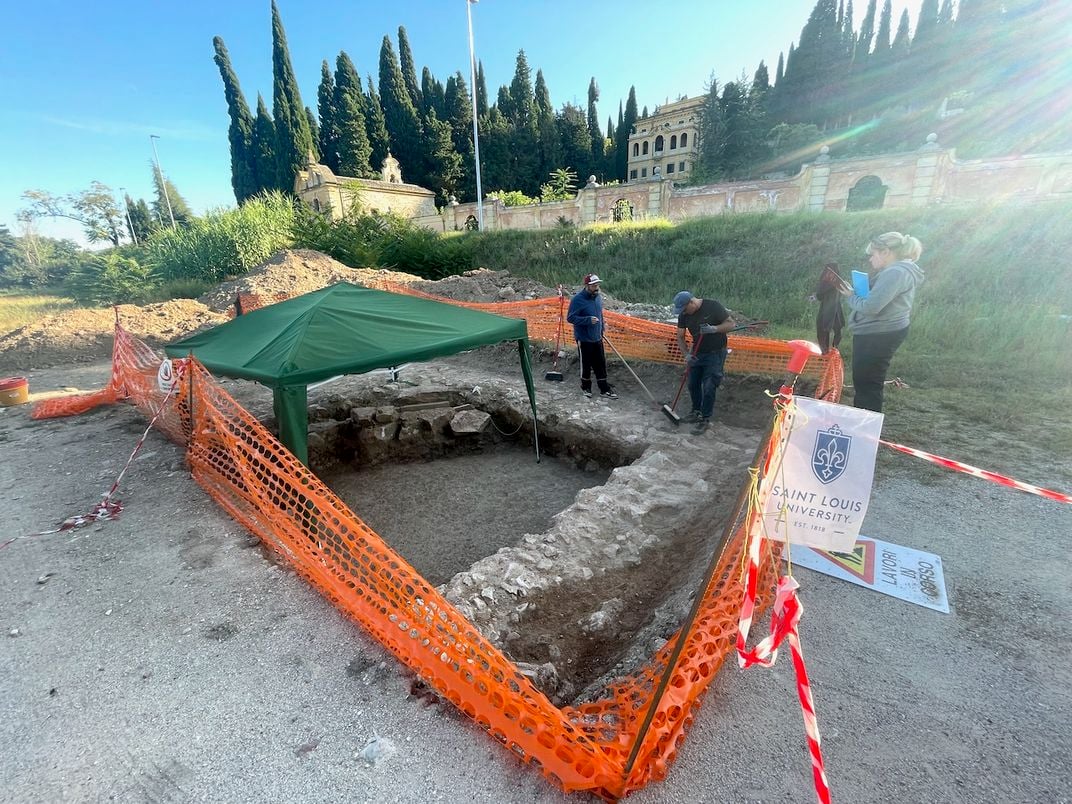
Boin first came to Spello because of a letter Constantine wrote to the townspeople during his reign. The rescript—an authoritative message from an emperor—was rediscovered in the 1700s and is now on display in Spello’s town hall, reports Newsweek’s Aristos Georgiou. In it, Constantine granted Spello’s people permission to celebrate a religious festival in their own town, rather than making the long journey to another, under one condition: They must build a temple dedicated to worshipping Constantine’s imperial ancestors.
At the time, the Roman Empire was in the midst of a dramatic cultural shift. After worshiping pagan gods like Jupiter, Juno and Minerva for centuries, its people were increasingly accepting Christianity. Constantine helped lead this transition, issuing a decree permitting Christian worship in 313 C.E.
The fourth-century rescript indicates, though, that the emperor entertained different religious values simultaneously: In addition to Christianity, he appears to have supported “imperial cult” traditions, which were based on the old Roman belief that emperors were divine figures.
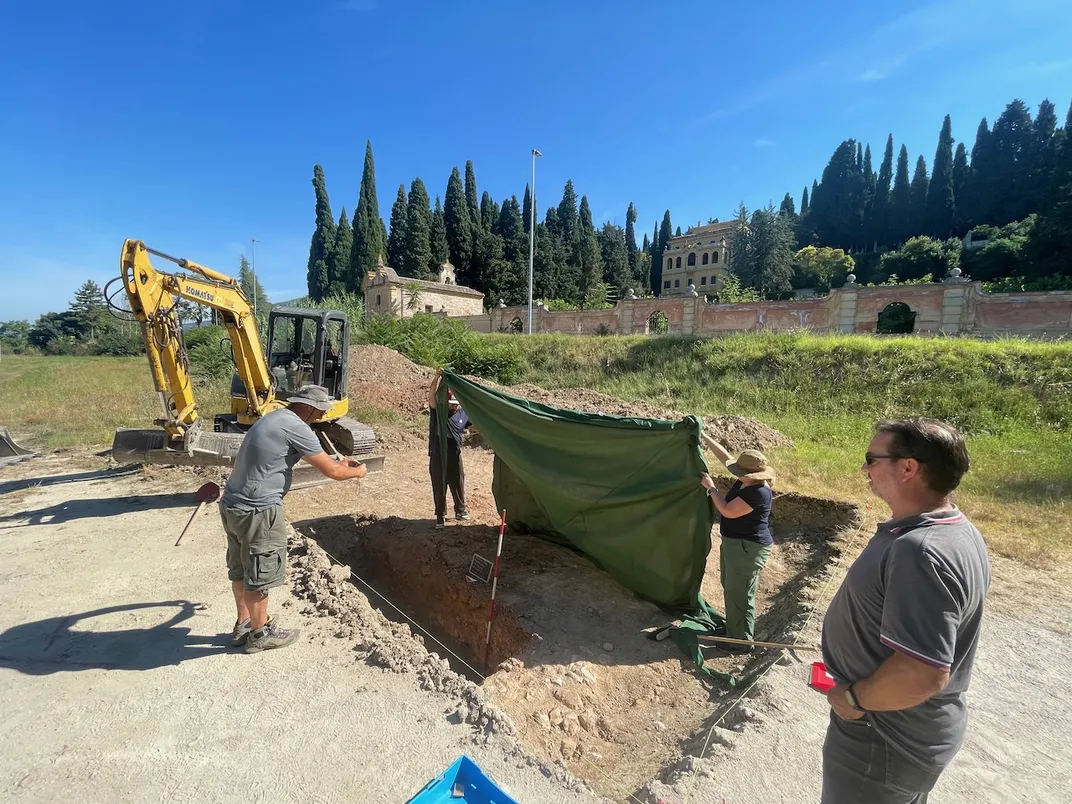
“The idea that Constantine is just as involved in promoting a pagan cult of the emperors as he is [in] embracing his own newfound Christianity is just one of these weird chapters in history I personally love,” Boin tells St. Louis Public Radio’s Elaine Cha. “It shows us that our neat and tidy way of understanding the past zigzags a lot more than we might be comfortable admitting.”
In Spello, Boin’s team performed underground imaging to scan for potential archaeological sites. Based on their findings, they decided to excavate the ground beneath a parking lot, where they unearthed what Boin thinks are the temple’s internal walls. He calls the find the most significant evidence of imperial cult practices in the late Roman Empire.
“There’s evidence from other places throughout the Roman world that Christian rulers supported imperial cult practices,” says Boin. “We’ve known that pagans worshiped at their temples in the fourth century, but those findings have all been small and inconsequential. And we’ve known that Christians supported the imperial cult, and we’ve known that without any sense of where it would have happened.”
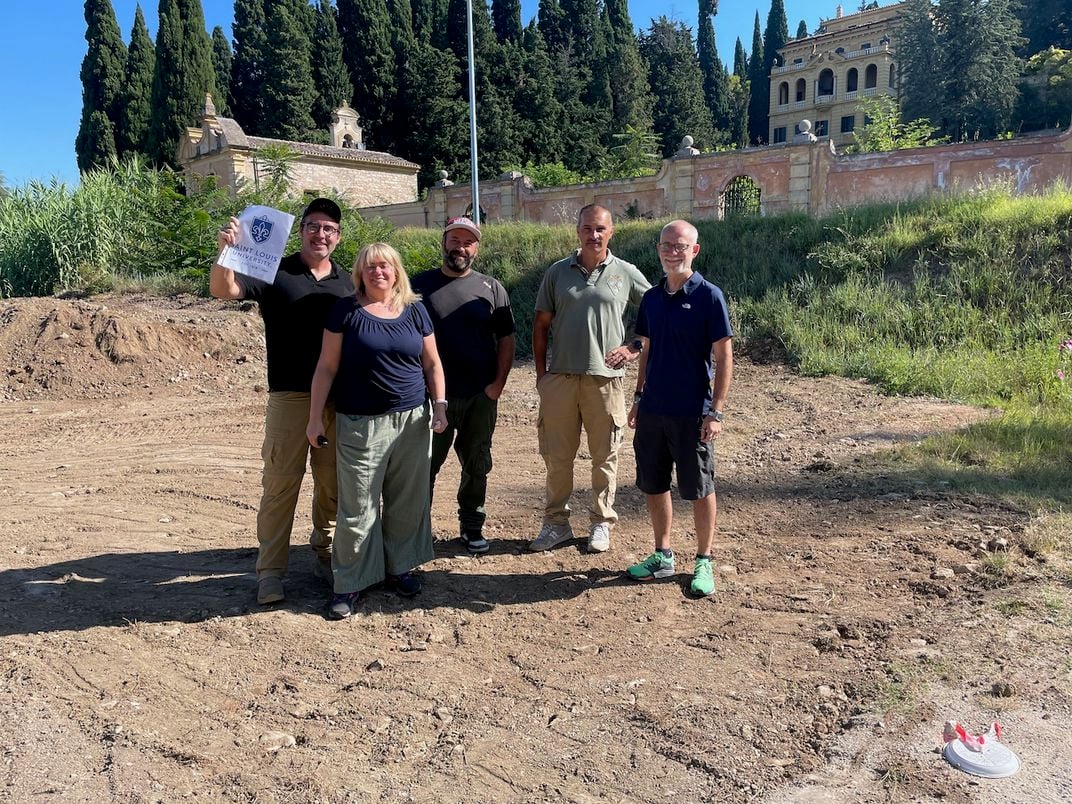
The newly discovered structure bridges these gaps in the historical record, he adds. “Any study of the imperial cult in the fourth-century Roman Empire is now going to have to take account of this temple.”
As Boin tells Newsweek, the temple was likely used for at least two generations, until officials prohibited pagan practices near the end of the fourth century. The temple’s continuous use through a period of cultural change illustrates its role as a unifying force.
“This building, in a very radical way on its own, shows us the staying power of the pagan traditions that had been on the ground for centuries prior to the rise of Christianity,” says Boin in the statement. “It shows us how the Roman emperors continued to negotiate their own values, their own hopes and dreams for the future of the emperor and the empire without knocking down or burying the past.”
Last edited:
divusiulius
The Force is Strong With This One
Boin said that the discovery of the pagan temple shows that there were
"continuities between the classical pagan world and early Christian
Roman world that often get blurred out or written out of the sweeping historical narratives."
I think this will help some scholar to re -examine the imperial cult history and perhaps someone will notice previously ignored details.
"continuities between the classical pagan world and early Christian
Roman world that often get blurred out or written out of the sweeping historical narratives."
I think this will help some scholar to re -examine the imperial cult history and perhaps someone will notice previously ignored details.
SasaM
Jedi Council Member
It seems counterintuitive that the (psycho) elite who basically did away with Caesar in that treacherous manner would have made an U-turn and resolve to worshipping him afterwards, except if not for some incentive for themselves to do so. I think that at least one thing remained 'constant' throughout the human history, that of MO of psychopathic individuals (on their path to acquiring more power for themselves), i.e. of uncreative STS energies and forces acting through them.Still going off my not-so-perfect memory here, but I think some distinctions still need to be made here. The boundary between gods and men for the Romans (at least, the Roman elite, not necessarily the plebs, about whom we probably don't know as much) of Caesar's time arguably wasn't as soft as it was in the provinces. In the book Cicero and the Rise of Deification in Rome, Spencer Cole basically argues that Cicero slowly, and over time, introduced this possibility into Roman official culture - primarily with the purpose of deifying himself. In a sense, he loosened up the Roman mentality that allowed for the deification of Caesar. But the Romans in general were much less open to the idea of a living god than the "Greeks" - Cicero wouldn't have had to try so hard if it was already a live option, I think. Again, maybe that didn't apply so much to the lower classes, who may have been more open to seeing things in those terms.
Taking into account also that later St. Paul, at least as far as I understand, was bringing and spreading the Good News and teaching his vision of the Kingdom of Heaven to ordinary people mostly, if not exclusively, I'd be looking for whatever traces might have been left of Caesar's worship (Imperial cult) from that time among the plebs first and foremost, while at the same time keeping an eye on the ground for spotting eventual reasons and development of historical events/situations that psychopathic elite individuals might have been prone to jump piggybacking the popular trend at some point.
FWIW.
Trending content
-
-
-
Thread 'Coronavirus Pandemic: Apocalypse Now! Or exaggerated scare story?'
- wanderingthomas
Replies: 30K
